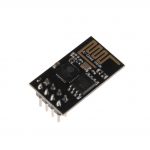JOY-it ESP8266 WiFi Module

Specifications
- Product Name: ESP8266 WiFi Module
- Voltage Supply: 3.3 V
- Current Supply: 350 mA
- Baudrate: 115200
Product Usage Instructions
- Initial Setup
- Open the preferences of your Arduino program and add the following line to the additional board manager URLs: http://arduino.esp8266.com/stable/package_esp8266com_index.json
- Download the additional data of the ESP8266 from the board manager.
- Select the ESP8266 as the board. Make sure to choose the accurate port from the menu Port.
- Connection of the Module
- Use with a TTL-cable:
- Verify that the TTL-adapter unit is set on a voltage supply of 3.3 V and a current supply of 350 mA.
- Connect the module with the TTL cable using the following chart:
- ESP8266: RX – TX – GND – VCC – CH_PD – GPIO0
- TTL-Kabel: TX – RX – GND – 3.3 V – 3.3 V – 3.3 V
- Use with an Arduino Uno:
- Connect the module with the Arduino Uno as per the chart provided.
- ESP8266: RX – TX – GND – VCC – CH_PD – GPIO0
- Arduino Uno: Pin 1 – Pin 0 – GND – 3.3 V – 3.3 V – 3.3 V
- Use with a TTL-cable:
- Code Transmission
- Demonstrate the transmission of the code with the example from the ESP8266-library.
- Select the desired code example from the Arduino software’s example menu.
- Set the baud rate (Upload Speed in Tools) for transmission to 115200.
FAQs
- Q: What should I do if I encounter unexpected problems during use?
- A: Please do not hesitate to contact us for assistance with any unexpected problems you encounter during use.
GENERAL INFORMATION
Dear customer,
Thank you for choosing our product. In the following, we will show what you should note at the commissioning and during the usage. Should you encounter any unexpected problems during use, please do not hesitate to contact us.
INITIAL SETUP
Open the preferences of your Arduino program and add the following line to the additional board manager URLs shown in the following pictures:
http://arduino.esp8266.com/stable/package_esp8266com_index.json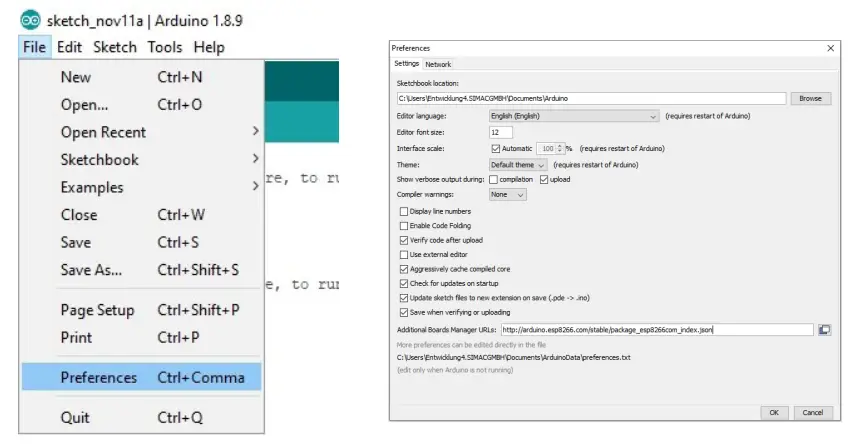
Download the additional data of the ESP8266 from the board manager.
Select now the ESP8266 as the board.
Attention! Please note that you must select the accurate port from the menu “Port“ which is beneath the board manager.
CONNECTION OF THE MODULE
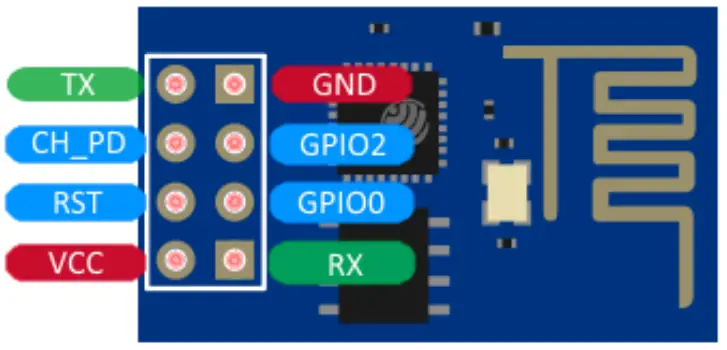
Use with a TTL cable.
Attention! Please note that the TTL-adapter unit is set on a voltage supply of 3.3 V and a current supply of 350 mA. Verify this if necessary. Connect the module with the TTL cable with the aid of the following chart. The pin assignment of the ESP8266 can be seen in the picture above.
ESP8266 TTL-Kabel
- RX TX
- TX RX
- GND GND
- VCC 3.3 V
- CH_PD 3.3 V
- GPIO0 3.3 V
Use with an Arduino Uno
Connect the module with the Arduino Uno with the aid of the following chart or rather the following picture. The pin assignment of the ESP8266 can be seen in the above-named picture.
ESP8266 Arduino Uno
- RX Pin 1
- TX Pin 0
- GND GND
- VCC 3.3 V
- CH_PD 3.3 V
- GPIO0 3.3 V
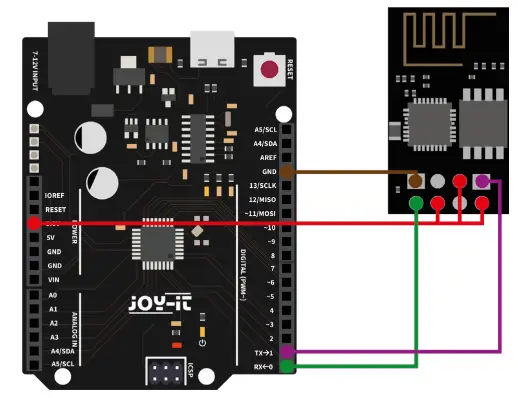
CODE TRANSMISSION
In the following, we demonstrate the transmission of the code with the code example from the ESP8266 library. To transfer the code to the ESP8266, you have to select the desired code example from the example menu of the Arduino software. The used baud rate (“Upload Speed“ in the menu “Tools“)for the transmission should be 115200.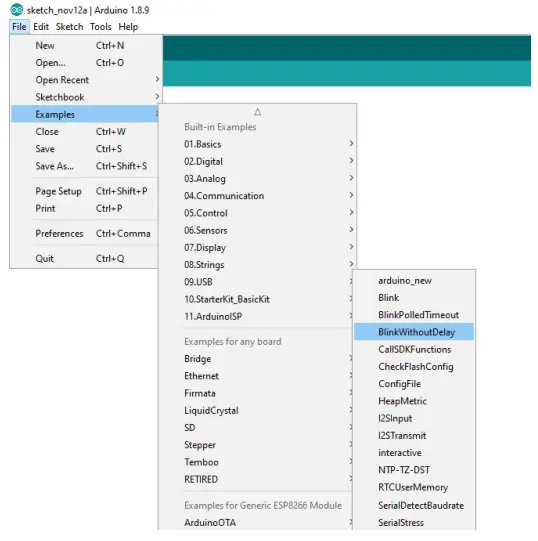
Attention! Before you can transfer the new code to the ESP8266, you must set the module into the programming mode:
For use with a TTL cable:
Separate the power supply (VCC) from the ESP8266 module and connect them again afterward. The module should start in the programming mode. If you do not have any success with this method, you can try the Arduino method. In some cases, this alternative works better even with the TTL cable.
For the use with an Arduino:
Separate the power supply (VCC) from the module and set the GPIO0 pin from 3.3 V to 0 V (GND). After that restore the power supply. As soon as the software has been transferred, the module can be set again to the normal operation status. For this, separate again the current supply, set the GPIO0 pin to 3.3 V, and restore the power supply.
When you have set the module into the programming mode, you can start the transmission Do not forget that you must switch back to the normal operation status after the transmission is finished.
FURTHER INFORMATION
Our information and redemption obligation according to the electro-law (ElektroG)
Symbol on electrical and electronic products :
 This crossed-out bin means that electrical and electronic products do not belong into the household waste. You must hand over your old appliance to a registration office. Before you can hand over the old appliance, you must remove used batteries and accumulators that are not enclosed by the device.
This crossed-out bin means that electrical and electronic products do not belong into the household waste. You must hand over your old appliance to a registration office. Before you can hand over the old appliance, you must remove used batteries and accumulators that are not enclosed by the device.
Return options :
As the end user, you can hand over with the purchase of a new device your old appliance (which has essentially the same functions as the new one) free of charge for disposal. Small devices that do not have outer dimensions greater than 25 cm can be submitted independently of the purchase of a new product in normal household quantities.
Possibility of restitution at our company location during our opening hours :
SIMAC Electronics GmbH, Pascalstr. 8, D-47506 Neukirchen-Vluyn
Possibility of restitution nearby :
We send you a parcel stamp with which you can send us your old appliance free of charge. For this possibility, you must contact us via e-mail at service@joy-it.net or via telephone.
Information about packaging:
Please package your old appliance safe during transport. Should you not have a suitable packaging material or you do not want to use your own material, you can contact us and we will send you an appropriate package.
SUPPORT
If any questions remain open or problems arise after your purchase, we are available by e-mail, telephone and with a ticket support system to answer these.
- E-Mail: service@joy-it.net
- Ticket-System: https://support.joy-it.net
- Telephone: +49 (0)2845 9360 – 50
- For further information visit our website:
- www.joy-it.net
Documents / Resources
 |
JOY-it ESP8266 WiFi Module [pdf] User Guide ESP8266, ESP8266 WiFi Module, WiFi Module, Module |


